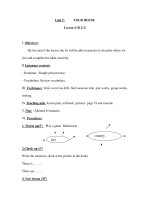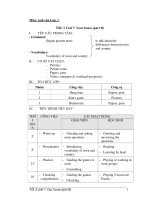unit 7 your house tiếng anh 6 sách cũ nguyễn văn liệt thư viện giáo án điện tử
Bạn đang xem bản rút gọn của tài liệu. Xem và tải ngay bản đầy đủ của tài liệu tại đây (120.97 KB, 5 trang )
<span class='text_page_counter'>(1)</span><div class='page_container' data-page=1>
<b>Period: 40</b>
<b>UNIT 7: YOUR HOUSE</b>
<b> B. Town or country (1)</b>
<b>I. OBJECTIVES </b>
<i><b>1. Knowledge, Skills, Attitude:</b></i>
<i><b>a. Knowledge:</b></i>
- Students identify places and their layouts.
<i><b>+ Grammar: </b></i>Do you live …? / Does she live …?; Is there …/ Are there any …?
<i><b>+ Vocabulary: </b></i> Words related to the topic: “Your house”.
<b>b. Skills:</b> Listening, speaking, reading and writing.
<b>c. Attitude:</b> Ss will be educated about keeping the town or the country clean.
<i><b>2. Capacity can be formed and developed for students </b></i>
- Self-learning capability.
- Cooperation capacity
- Communicative competence
<b>II. Preparation</b>
<i><b>1. Teacher: </b></i>lesson plane, book, color chalks, pictures, cassette and tape
<i><b>2. Students:</b></i> books, notebooks, pen, ruler …
<b>III. Students’ activities</b>
<i><b>1. Warm up: </b></i>Lucky number (5’)
<b>Teacher’s and students’ activities</b> <b>Content</b>
- Ss play “Lucky number”.
- T congratulates the team that wins the game. <b>15</b> <b>26</b> <b>37</b> <b>48</b>
1. What is in front of your house?
2. Lucky number
3. Where are the mountains?
4. Lucky number
5. Lucky number
6. Where is the yard?
7. Are there any trees near your house?
8. Lucky number
<i><b>2. Knowledge formation activities (36’)</b></i>
- T introduces the lesson.
- T has Ss look at the picture and describe in
Vietnamese.
- Ss look at it and describe.
- T elicits new words then reads.
- Ss listen and repeat.
- T has Ss read again.
- Ss read then give the answer.
- T corrects.
- T helps Ss know how to answer the question.
<b>* Presentation:</b>
<b>1. Listen and read. Then choose the correct</b>
<b>answers.</b>
<i>* Students identify places and their layouts and ask </i>
<i>and answer with yes-no questions.</i>
<b>* Vocabulary:</b>
- apartment (n) (A.E) căn hộ = flat (n) ( BE)
- clinic (n) phòng khám
- market (n) chợ
- zoo (n) vườn thú
- noisy (a) ồn ào
- quiet (a) yên tỉnh
* <i><b>Structure</b></i>:
Do you live in town? -> - Yes, I do / No, I don’t.
Does he live in the country? -> - Yes, he does /
No, he doesn’t.
- T has Ss read the text.
- Ss work in individual.
- T has Ss compare the answers with their friends.
- Ss work in pairs.
<i><b>The answer:</b></i>
</div>
<span class='text_page_counter'>(2)</span><div class='page_container' data-page=2>
- T calls Ss to give the answers before class.
- Ss give the answers.
- T corrects.
d) No, she doesn’t.
e) No, there aren’t.
f) Yes, it is.
- T asks Ss to describe something about their
places.
- Ss describe in front of class.
- T corrects if necessary.
<b>Free practice:</b>
<i><b>3. Consolidation (4’)</b></i>
- Ss talk about your place of living.
<b>IV. Experience:</b>
………
………
………
Period: 41
<b>UNIT 7: YOUR HOUSE</b>
<b>B. Town or country (2,3,4)</b>
<b>I. Objectives: </b>
<i><b>1. Knowledge, Skills, Attitude: </b></i>
<i><b>a. Knowledge</b></i>
- Students identify places and their layouts.
<i><b>+ Vocabulary: </b></i>- Words related to the topic: “Your house”
<i><b>+ Grammar: </b></i>- Present simple tense
- There is not (There isn’t), There are not (There aren’t)
- Near the apartment, there is a market
<i><b>b. Skills:</b></i> listening, speaking, reading and writing
<i><b>c. Attitude:</b></i> - Students identify places and their layouts.
- Ss will be educated about keeping the town or the country clean.
<i><b>2. Capacity can be formed and developed for students </b></i>
- Self-learning capability.
- Cooperation capacity
- Communicative competence
<b>II. Preparation</b>
<i><b>1. Teacher: </b></i>lesson plane, book, color chalks, pictures, cassette and tape
<i><b>2. Students:</b></i> books, notebooks, pen, ruler …
<b>III. Students’ activities</b>
1. Warm up: Jumble words (5’)
<b>Teacher’s and students’ activities</b> <b>Content</b>
<b> - </b>Play “<i><b>Jumble words</b></i>”.
- Ss do as teacher’s directed.
- T follows and announces the team that wins.
- Ss clap their hands.
Effcoi = office
Rasutpemrke = supermarket
Selwfor = flowers
Ccnlli = clinic
Sydfaidpedl = paddy fields
<i><b>2. Knowledge formation activities (32’)</b></i>
- T introduces the lesson.
- T has Ss read the text.
- Ss work in individual.
- T has Ss choose the answer.
- Ss choose the answer.
- T corrects.
<b>* Presentation:</b>
<b>2. Read about Ba. Then write sentences about </b>
<b>Chi.</b>
<i>* Ss write sentences about Chi’s house.</i>
<i><b>The answer:</b></i>
</div>
<span class='text_page_counter'>(3)</span><div class='page_container' data-page=3>
- T has ss read.
- Ss read.
- T elicits how to write.
- Ss notice.
- T has written on the board.
- Ss write.
- T corrects.
<b>* Practice:</b>
- T introduces B3.
- Ss listen.
- T plays the tape.
- Ss listen and complete the table.
- T asks Ss compare with their friends.
- Ss work in pairs.
- T calls Ss to give the answers.
- Ss give the answers before class.
- T corrects.
<b>3. Listen and check. Complete this table in your </b>
<b>exercise book.</b>
<i>* Ss listen and write the places where Tuan, Minh,</i>
<i>Nga live.</i>
- Where do you live?
- Where does he/ she live?
<i><b>3. Consolidation 4’</b></i>
- Ss talk about your place of living.
<i><b>4. Its operations 4’</b></i>
- T asks Ss to remind whole the knowledge in the
lesson and say how to use.
- Ss retell before class.
- T comments and correct if necessary.
- Ss retell before class.
- T comments and correct if necessary.
<b>4. Remember</b>
<i>Do you live in town?</i>
<i>No. I live in the country.</i>
<i>Does he live in town?</i>
<i>No. He lives in the country.</i>
<i>Aren’t = are + not</i>
<b>IV. Experience:</b>
………
………
………
Period: 42
<b>UNIT 7: YOUR HOUSE</b>
<b>(C1)</b>
<b>I. Objectives: </b>
<i><b>1. Knowledge: </b></i>
<i><b>a. Knowledge</b></i>
<i><b>- </b></i>Students ask and to answer about kind of transport and how to travel.
<i><b>+ Vocabulary:</b></i> - Words related to the topic: “your house”.
<i><b>+ Grammar: </b></i> - How do you go to school?
- I go to school by bike.
<i><b>b. Skills:</b></i> listening, speaking, reading and writing
<i><b>c. Attitude:</b></i> - Students ask and to answer about kind of transport and how to travel.
- Ss will be educated about how to go to school.
<b>II. Preparation</b>
<i><b>1. Teacher: </b></i>lesson plane, book, color chalks, pictures, cassette and tape
<i><b>2. Students:</b></i> books, notebooks, pen, ruler …
<b>III. Students’ activities</b>
<i><b>1. Warm up: Network (5’)</b></i>
<b>Teacher’s and students’ activities</b> <b>Content</b>
- Play “Network”.
- Ss do as teacher’s directed.
xe đạp xe máy
tàu hỏa
Name City Town Countr
y
Apartmen
t
house
Minh v x x v x
Tuan x v x x v
Nga v x x x v
</div>
<span class='text_page_counter'>(4)</span><div class='page_container' data-page=4>
- T follows and announces the team that wins.
- Ss clap their hands.
đi bộ ô tô
<i><b>2. Knowledge formation activities (36’)</b></i>
- T introduces the lesson.
- T has Ss listen to the lesson.
- Ss listen.
- T elicits new words.
- Ss copy down.
- T has Ss read again.
- Ss reads again.
- T corrects.
- T has Ss listen to the dialogue.
- T explains the question.
- Ss listen and take notes.
- T has Ss listen and repeat then work in pairs.
- Ss listen and work in pairs.
- Ss work in pairs.
- T asks some pairs to play the roles.
- Ss play the roles.
- T corrects.
<b>* Presentation :</b>
<b>1. Listen. How do you go to school?</b>
<i>* Ss ask and answer about the transport to</i>
<i>travel.</i>
<i><b>* Vocabulary:</b></i>
- bike (n) xe đạp
- motorbike (n) xe máy
- bus (n) xe buýt
<b>- </b>car (n) xe hơi
- walk (v) đi bộ
Ex:
How do you go to school?
I go to school by bike.
<i><b>* Structures :</b></i>
<b>How do/does + S + go +……?</b>
<b>S + go/goes ….. by……</b>
- T has Ss ask and answer about the people in the
pictures.
- Ss practice in pairs.
- T has some pair ask and answer before the class.
- Ss ask and answer.
- T corrects.
<b>* Practice :</b>
<i>Now ask and answer questions about these</i>
<i>people:</i>
<i>Example:</i>
How does Lien go to school?
She goes by bike
I go to school by motorbike.
What about you?
What about your father/ mother?
<i><b>3. Consolidation (4’)</b></i>
* Complete the sentences:
- ……. do you go to the market? -> I go there ……… bus.
……….does Mr Linh travel to work? -> He……. by car.
<b>IV. Experience:</b>
………
………
………
Signature
</div>
<span class='text_page_counter'>(5)</span><div class='page_container' data-page=5></div>
<!--links-->









